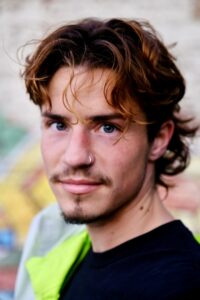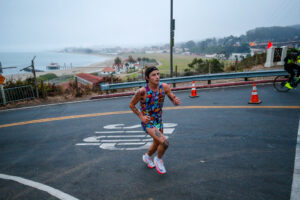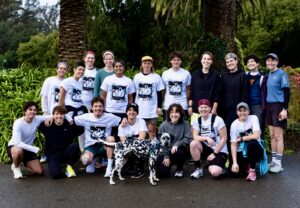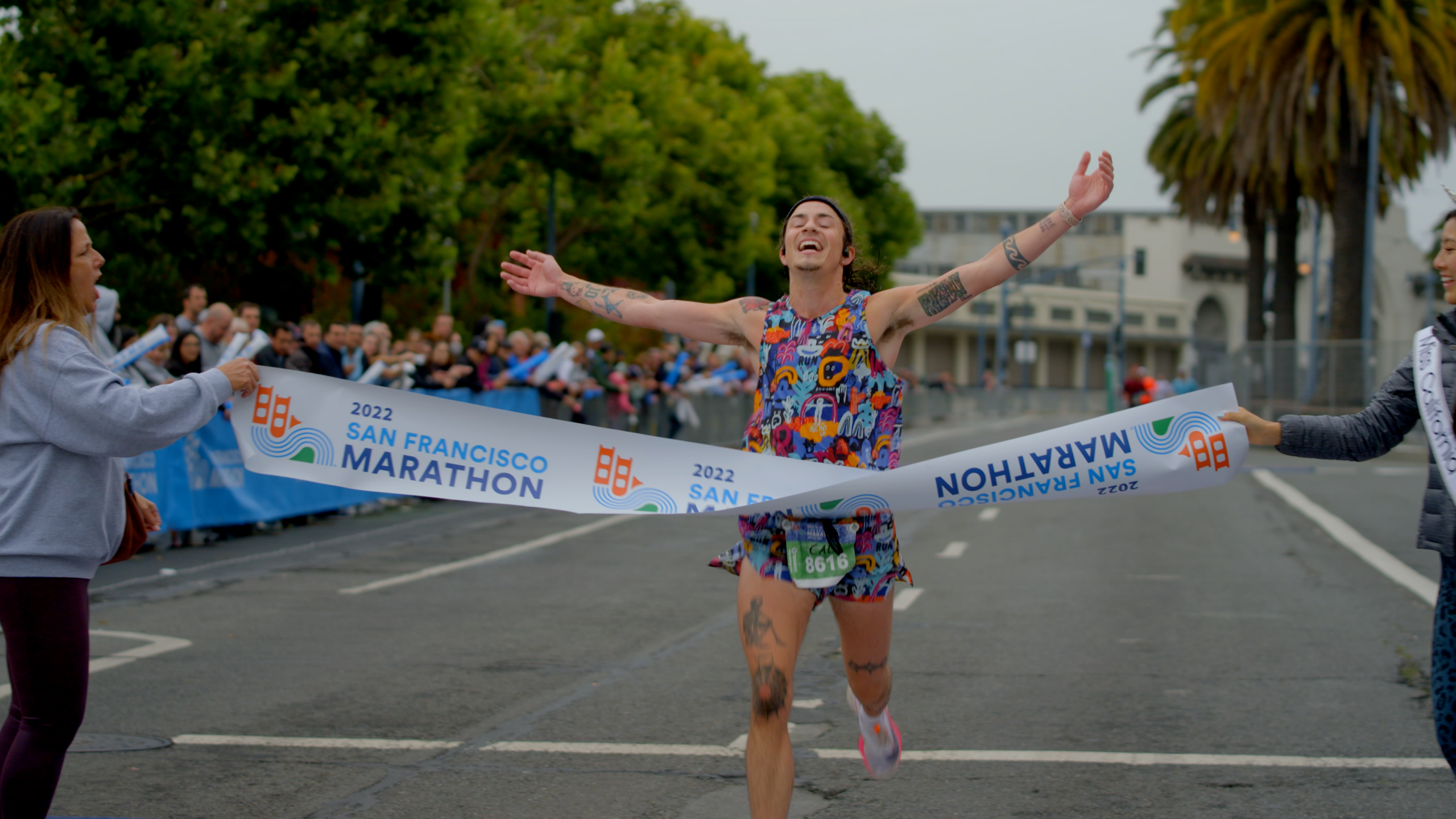Cal Calamia Heads to Boston, Open for the First Time to Gender-Expansive Runners
The first winner of the San Francisco Marathon’s NB+ category, Cal Calamia, is heading to the world-famous Boston Marathon. A gender-expansive runner, Calamia is one of the thousands of runners who can, for the first time ever, run this course as themselves. Why was Calamia ready to give up on their dream of running Boston? How did the San Francisco Marathon help pave the way? And what does Calamia’s training look like? Read this and more in the following article.
Written & edited by Pavlína Marek
In 2022, Cal Calamia was the first runner in the NB+ category to cross the finish line of the San Francisco Marathon. Their joy radiated even from the finish line photos and, with a finishing time of a perfect 3 hours, they undeniably qualified for the Boston Marathon. Even though they were elated upon realizing their dream of running Boston was within reach, they weren’t sure they could do it. The final decision was up to the organizers: would they create a non-binary category to help fulfill the claim that running is for everyone?
The Rocky Road to Boston
Forget Dublin; the real rocky road leads to Boston. As the Boston Marathon grew more famous, the qualifying times got stricter and fewer runners were able to qualify. Nowadays, only the best are rewarded with the opportunity to run this race.
“I have been dreaming about running Boston since I started running marathons,” Calamia said. After all, it’s one of the most prestigious marathons in the world. For them, “the pinnacle of being a marathon runner is being able to go and run Boston.”
Calamia has, in fact, qualified for the Boston Marathon in the past. It was before they began to transition but they were “still going to run it,” even if it was going to be in a category they didn’t feel they belonged in. However, life had other plans. Calamia tore their ACL before the big race and had to postpone fulfilling their dream.
It was a challenging time for Calamia. However, it offered them the space to really think about their goals. Did they just want to run the Boston Marathon, or did they want to make a lasting change and make the beautiful sport that is running more accessible? Instead of self-pity, Calamia chose gratitude and action.

Cal Calamia. Photo credit: Ariel Robbins
“It was, in some ways, what needed to happen so that I could spend more time figuring out who I was and working with the organizations themselves to make more space for people to run as they truly are.”
Had Calamia run the Boston Marathon back then, they would have done so in the female category. “I don’t think I would have received much push-back because I was presenting more androgynously,” Calamia said. “But I think it would have been uncomfortable for me.”
The forced time off from running offered Calamia the space to start their activist journey.
For many gender-expansive runners, the process of picking up a bib, showing their ID, running in a category they don’t feel they belong in, and answering a hundred different questions about that can be very stressful. Especially for runners who are further along in their transition journey, this can be even more challenging.
“[Running in the female category] would create unnecessary stress. Now, it will be a celebration of who I and other non-binary and trans runners are … as opposed to this daunting, stressful aura that would have otherwise been around,” they said.
However, had the Boston Marathon not created a division for gender-expansive runners, Calamia was ready to give up on their dream in order to continue their mission to make the sport accessible to more people.
“I set this bar. I’m not going to run, I’m not going to compete in a race if they don’t have a category for [people like me].”
Belonging: The San Francisco Marathon
In July 2022, Cal Calamia toed the line of the San Francisco Marathon. They didn’t intend to run the marathon that year. They planned and trained for the half marathon, more for fun than anything else. Then they found out about a change in the race’s gender divisions—and their plans changed.
“I was just so excited about the NB+ category,” Calamia said. The decision to run the full marathon was made: “This is the first time this has ever happened and I’m just gonna go for it.”
For the first time in the race’s history, Calamia and other runners got to “celebrate [their] gender and who [they are] as [people].” Whether they expected it or not, the San Francisco Marathon helped them realize what running as one’s true self can be like.
“It was the most exciting race experience I had ever had because I felt like I wasn’t hiding any part of myself in the race.”
The positive experience at the San Francisco Marathon “served as a turning point for what it means to run a race in general.”
“It was a really cool moment when I realized that change is possible,” said Calamia. The decision was made then; they’d only run races that had a category for gender-expansive runners. “And even if they do have a category, I’m still going to provide feedback on ways that the category or the race, in general, could be more inclusive.”

Cal Calamia runs up a hill on the San Francisco Marathon Course.
Calamia believes that a category for runners who don’t fit the gender binary could become the standard. Instead of just accepting that a race doesn’t have a category that would allow everyone to participate, it’s now clear that with a little effort, everybody can have a category to run and feel comfortable in.
“[The San Francisco Marathon] set this bar on top of being a really exciting experience in general,” said Calamia. “It reignited, in some ways, my desire to do marathons.”
Despite their condensed training cycle, the name of the NB+ category winner was Cal Calamia. The finisher photos show them with a wide grin plastered on their face. For Calamia, the San Francisco Marathon turned out to be “such a joyous experience.”
To say they were excited about winning is an understatement. Even though Calamia describes the course as “challenging, obviously,” they ran it in 3 hours flat. With that time, they “officially qualified under all the different gender standards that Boston then did publish,” as Calamia said.
“For me, it meant something. It meant that even if they didn’t have this category, which I’m really glad they do, I would have qualified regardless.”
Thus, Calamia met all standards and proved they really belong to Boston. They had the security that, “as long as [the Boston Marathon] had space for non-binary runners,” they could run the race.
Before the San Francisco Marathon, they hadn’t done one in a while. Calamia “just pulled this one out of nowhere.” And because training is, understandably, an integral part to successfully running a marathon, Calamia decided to create a running group where gender-expansive people can train while they keep each other safe and supported. The San Francisco Bay Area was the perfect place for that.
Cal Calamia’s Non-Binary Run Club
“Ultimately, helping trans and non-binary people be healthier, get more active, and find themselves through running is a dream.”

Cal Calamia and the Non-Binary Run Club. Photo Credit: Ariel Robbins
Many races are opening up categories for gender-expansive runners. As the sport opens up and becomes more inclusive, more people are taking to roads and trails to train. To support gender-expansive runners in the Bay, Calamia started organizing group runs for all these runners who don’t necessarily fit the gender binary mold.
“The goal is to create a space where trans and non-binary runners can come out and just be in community and feel supported by each other,” said Calamia.
However, no matter what Calamia expected, these runs surpassed their expectations. Eight runners took part in the club’s first run in December 2022. January brought over 20 runners. The club is quickly growing—but it’s not just the number of runners that joined. It’s the distance they went to be able to become a part of this community. Runners from as far as Portland ran with their now-peers in the Bay and found support in the beautiful community Calamia had created.
“It’s been so surprising and exciting to see how many people have shown up,” said Calamia. “We’ve had people drive from Portland and Southern California all the way to San Francisco just to run together!”
Taking Time to Train

Cal Calamia on Ocean Beach. Photo Credit: Ariel Robbins
Cal Calamia is a busy person, to say the least. The Bay Area is “a very expensive place to live, and teaching is not a very high-paying career,” as they said. “I definitely have to do more to supplement my income to make my life work.” This leaves them with a limited amount of one crucial resource: time.
Calamia already knew that training for a marathon takes a lot of time. “But it also takes a lot of privilege, too, to be able to train for a marathon. To have that much time to get in your 15-mile run when you also have a 9-hour workday,” they said.
To squeeze everything into the 24 hours we all get every day, Calamia modifies and prioritizes as much as they can. They come home from work, rest for 30 minutes, run 7 miles, shower, then head to their evening class. “My social life definitely sees some fluctuation so I have to be really intentional about planning time to see friends.”
Simply said, “it’s a lot.”
Rest & Recovery
Because of their busy life, rest plays an integral part in Calamia’s game plan not only on rest days but also whenever their body asks for it. If they have a difficult day at work, do extra work for the nonprofit, and have grad school in the evening, the decision has to be made: “Maybe, more than I need to go for my 8-mile run today, I actually need to not do anything.”
Choosing rest can be challenging and stressful when one has planned a 40-mile week and only did 32 miles. “But ultimately, I know that rest is also very important for my body,” Calamia said.
“Whenever you’re running more than 20 miles a week you have to be extra intentional about what you’re eating, how much you’re sleeping, and things like that.” It can be challenging to juggle all these things, but, “especially when putting so many miles on my body, I have to be able to rest, have time to cook, [or] go grocery shopping.”
Calamia is consistently building their mileage while they try to do as many marathon-paced runs as they can. They plan to hit around 50 to 55 miles per week, which “is on the lower end when training for a marathon.” However, it’s the right fit for them, considering their busy life.
Cal Calamia’s Boston Goals
There are two goals Calamia is trying to choose from. One, they can attempt to run the fastest marathon they’ve ever run.
“I want to PR… [and] I definitely feel like it’s possible,” said Calamia.
But, two, there’s the option to simply have a celebratory run. A run that would acknowledge all Calamia and other gender-expansive runners had to go through to get to this point where they’re finally able to run as themselves.
“What I really want to give myself permission to do is to have fun and just enjoy the fact that this category exists.”
As Calamia’s training evolves, they’ll be able to better tell if they can achieve both of those goals at the same time.
Find Calamia here:


